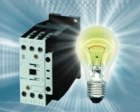Make light work of switching

Lighting loads pose special demands on switching contactors, with electronic ballasts for high-efficiency fluorescent lighting being more demanding than traditional ballasts.
With energy-hungry filament lamps soon to be history and low-energy bulbs growing fast in popularity, it is time to revisit the subject of selecting contactors for switching lighting loads — as Steve Rickard explains. Lamp loads are anything but resistive. An ordinary tungsten filament bulb can draw an inrush current at the instant of switch on that is up to 16 times its normal operating current. More exotic lamps can also be very demanding in their switching requirements with, for example, the sodium-vapour lamps sometimes used for outdoor lighting typically drawing 2.2 times their nominal operating current for up to 10 minutes while they are warming up. It is for these reasons that leading contactor manufacturers, such as Moeller Electric, have introduced products that are specifically optimised for switching lighting loads. Key features include extra-large terminal clamps to accommodate the oversize cables needed to avoid voltage drops on long wiring runs and contacts that are designed to handle reliably the large inrush currents associated with many types of lighting load. Even when lighting contactors are used, however, it is still important to choose a device with a rating that it appropriate to the types of lamps in use. It is easy to see why if we use the ratings of Moeller Electric’s DILL12 contactor as an example. This has a thermal rating of 27A, which falls to 14A for a tungsten filament lamp load. For fluorescent tubes with conventional ballasts, the rating is 20A, but for fluorescent lamps with electronic ballasts the rating is 12A. Herein lies a pitfall for the unwary! Low-energy bulbs are, in fact, compact fluorescent lamps (CFLs) with electronic ballasts. When choosing contactors for switching loads of this type, therefore, the appropriate rating must be used — 12A in our example. That is not much lower than the tungsten rating of 14A, but the difference could still lead to shortened contactor life. The situation is much worse if the contactor rating for conventional fluorescents (20A) is used in error with CFLs (which have electronic ballasts) where, as we have seen, the correct rating is 12A. With such a large difference in the ratings, problems are virtually guaranteed! In other words, a contactor sized for switching fluorescent lighting with conventional ballasts will be nearly 100% under-rated for electronic ballasts. Note that similar issues arise in lighting installations that are updated by replacing conventional fluorescent luminaires with modern energy-efficient electronic-ballast types. It is perfectly possible that the existing contactors will be too small to switch new load and, therefore, will also need to be replaced. There is another easily forgotten factor that needs to be taken into consideration when selecting a lighting contactor, and that is power factor correction. Many types of luminaire — including most fluorescent types — have poor power factors. Luminaire manufacturers frequently compensate for this by building in power-factor-correction capacitors. These capacitors, however, draw a big spike of charging current when the luminaire is turned which, if an installation includes numerous luminaires, can be sufficient to damage the contactor. For this reason, contactor manufacturers specify a maximum capacitor load that can be switched by their products, which must be taken into account when choosing a contactor. Although this article has concentrated on tungsten and fluorescent lamps, as these are the types most commonly used, certainly for indoor applications, there are, of course, many other types of lamp. The same rules of contactor selection apply to all lamps. First determine the type of lamp and, where appropriate the type of ballast. Then choose a contactor with an adequate current rating for this type of lamp load. Finally, check that the contactor’s maximum capacitor load is not exceeded. The key to success is having access to accurate and comprehensive data on switching lighting loads from the contactor manufacturer. Leading companies like Moeller Electric invariably make this data easily available and will also be ready to provide additional advice and support in dealing with more difficult applications, such as those involving mixtures of luminaire types. Steve Rickard is with Moeller Electric
Related links:
Related articles:


